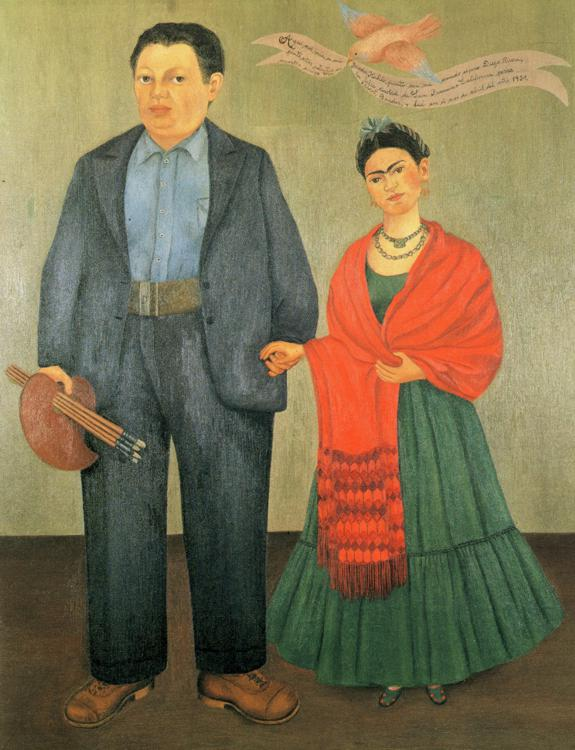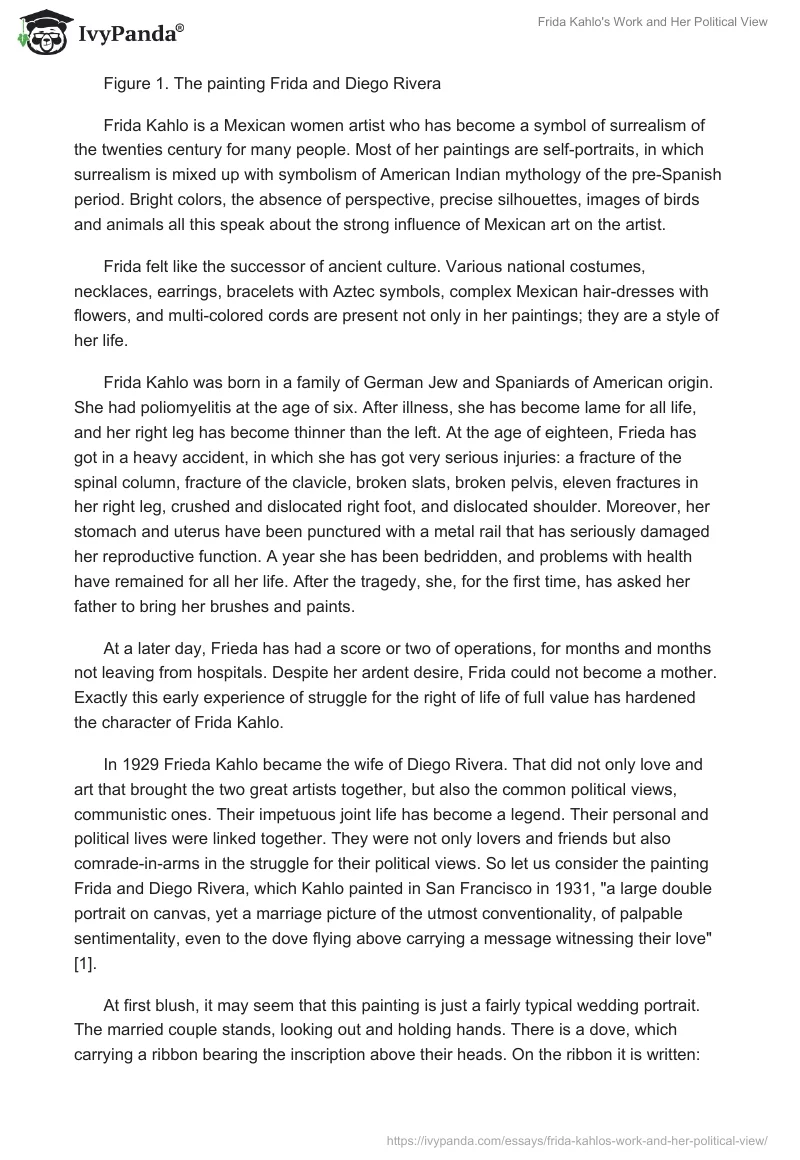
Frida Kahlo is a Mexican women artist who has become a symbol of surrealism of the twenties century for many people. Most of her paintings are self-portraits, in which surrealism is mixed up with symbolism of American Indian mythology of the pre-Spanish period. Bright colors, the absence of perspective, precise silhouettes, images of birds and animals all this speak about the strong influence of Mexican art on the artist.
Frida felt like the successor of ancient culture. Various national costumes, necklaces, earrings, bracelets with Aztec symbols, complex Mexican hair-dresses with flowers, and multi-colored cords are present not only in her paintings; they are a style of her life.
Frida Kahlo was born in a family of German Jew and Spaniards of American origin. She had poliomyelitis at the age of six. After illness, she has become lame for all life, and her right leg has become thinner than the left. At the age of eighteen, Frieda has got in a heavy accident, in which she has got very serious injuries: a fracture of the spinal column, fracture of the clavicle, broken slats, broken pelvis, eleven fractures in her right leg, crushed and dislocated right foot, and dislocated shoulder. Moreover, her stomach and uterus have been punctured with a metal rail that has seriously damaged her reproductive function. A year she has been bedridden, and problems with health have remained for all her life. After the tragedy, she, for the first time, has asked her father to bring her brushes and paints.
At a later day, Frieda has had a score or two of operations, for months and months not leaving from hospitals. Despite her ardent desire, Frida could not become a mother. Exactly this early experience of struggle for the right of life of full value has hardened the character of Frida Kahlo.
In 1929 Frieda Kahlo became the wife of Diego Rivera. That did not only love and art that brought the two great artists together, but also the common political views, communistic ones. Their impetuous joint life has become a legend. Their personal and political lives were linked together. They were not only lovers and friends but also comrade-in-arms in the struggle for their political views. So let us consider the painting Frida and Diego Rivera, which Kahlo painted in San Francisco in 1931, “a large double portrait on canvas, yet a marriage picture of the utmost conventionality, of palpable sentimentality, even to the dove flying above carrying a message witnessing their love”.
At first blush, it may seem that this painting is just a fairly typical wedding portrait. The married couple stands, looking out and holding hands. There is a dove, which carrying a ribbon bearing the inscription above their heads. On the ribbon it is written:
Here you see us, Me Frieda Kahlo, with my beloved
husband Diego Rivera. I painted these portraits in the
the beautiful city of San Francisco, California for our
friend Mr. Albert Bender, and it was in the month of
April in the year 1931.
Frida and her husband are standing, not quite centered, and almost filling the frame. Tomsheck, in his paper written for the Modern and Contemporary Art History course, writes: “Diego stands feet splayed firmly grounded. He gazes out at the viewer, confident and calm. In his right hand, he holds a pallet and brushes, clearly identifying him as an artist. With his left hand, he lightly clasps Frida’s right hand. This gesture appears normal, but upon closer inspection, it is highly unusual. By placing Diego’s pallet in his right hand and herself in his left, Frida is making a statement as to the roles that will be played. Diego is an artist first and her husband second. The statement is further enforced by the way Diego’s head is turned. He glances sideways, almost slyly, out at the viewer. He seems almost to be in motion as if he has stopped to pose for this portrait, but only momentarily.
Frida, on the other hand, inclines her head toward Diego and looks out directly at the viewer. Where Diego is grounded and solid, Frida seems insubstantial, almost a floating figure. Her tiny feet peer out from her skirt and seem almost too delicate to support any weight. It is almost as if she could reach up, clasp the ribbon above her head, and be carried away. She is, nonetheless, not a weak presence. Though Diego is the stronger figure in the painting, Frida’s red shawl immediately draws the eye. In the end, her presence is much more noticeable than Diego’s. If she were removed from the piece, it would be far less interesting and probably not noteworthy at all”.
As a matter of fact, art was not the only important thing in the life of Frida. She has also been involved in political issues of her epoch. Let us consider her political role back in the era. Doy states that “however Kahlo was not just concerned with female self-image in her activities, she was also a political activist, and a tendency to ignore this has not helped develop an analysis of Kahlo’s work which would attempt to relate her political views and activities to her presentation of herself as a Mexican, a woman and an artist”. Frida was a communist. She entered the Mexican Communist Party in 1928 but in a year has left it on the morrow of excluded Diego Rivera. And in ten years, true to her ideological beliefs, she has entered Communist Party again.
In her house on the book, shelves were the dog-eared volumes of Marx, Lenin, Stalin’s works, next to them Zinovyev, published in 1943 in Mexico City, ready at hand Grossman’s publicist devoted to Great Patriotic War, and absolutely unexpected “Genetics in the USSR.” In her bedroom, in the head of the bed, hung big portraits of founders of Marxism-Leninism and their most gifted followers. In particular, there was Mao Tse-tung in a beautiful wooden frame, the increased photo of Lenin, who performed from a tribune on the Red Square before Red Army men leaving to the front. She has also had not finished a portrait of Stalin. The leader is represented severe, with his eyebrows knitted, in a white full-dress coat, with one golden marshal shoulder-strap. The second strap Frida had no time to finish…
Her personal diary was filled not only with declarations of love for Diego but also with assurances of her faith in the Communist Party: “I am a communist,” she wrote. “I clearly understand the materialist dialectics of Marx, Engels, Lenin, Stalin, Mao Tse … I love them as pillars of the new communist world”.
In the thirties of the twentieth century, Frida, for some time, lived in the USA, where Diego worked. This long under the necessity stay abroad, in the developed industrial country, has forced the woman artist to feel national distinctions more sharply. Since then, Frida, with a special love, treated Mexican national culture, collected ancient products of art, and even in her daily life wearing national costumes. The trip to Paris in 1939, where Frida became a sensation of a thematic exhibition of Mexican art (one of her pictures has been even got by the Louver), has even more strongly developed her patriotic feeling.
By her extremely individual images, Frida has destroyed interdictions of her time, in particular those, which that surrounded her female body and her sexuality. In 1950th, Diego Rivera recognized her as the first woman in the history of art by the woman, who with absolute, uncompromising honesty, possible even to say, with quiet cruelty, spoke about important and concrete questions.
Bibliography
- Smith, Terry. Making the Modern: Industry, Art, and Design in America. Chicago: University of Chicago Press, 1993. p. 259.
- Herrera, Hayden. Frida A Biography of Frida Kahlo. New York: Harper & Row Publishers, 1983. p. 124.
- Tomsheck, L. “The paper written for the Modern and Contemporary Art History course and read at the Sixth Annual Art History Forum at The University of West Georgia.” lagrange.edu. Web.
- Doy, Gen. Seeing and Consciousness: Women, Class, and Representation. Oxford: Berg, 1995. p. 175.
- Franco, Jean. The Decline and Fall of the Lettered City: Latin America in the Cold War. Cambridge, Mass: Harvard University Press, 2002.p. 59.


